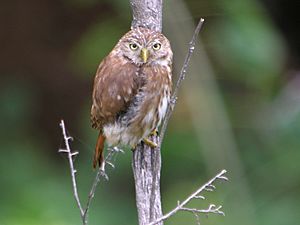Pacific pygmy owl facts for kids
Quick facts for kids Pacific pygmy owl |
|
|---|---|
 |
|
| Conservation status | |
| Scientific classification | |
| Genus: |
Glaucidium
|
| Species: |
peruanum
|
 |
|
| Distribution of Pacific pygmy owl Resident | |
The Pacific pygmy owl (also called the Peruvian pygmy owl) is a small owl found in Chile, Ecuador, and Peru. Its scientific name is Glaucidium peruanum.
Contents
What is a Pacific Pygmy Owl?
A German bird expert named Claus König first described the Pacific pygmy owl as its own species in 1991. Before that, people thought it was just a type of ferruginous pygmy owl.
Claus König noticed that the Pacific pygmy owl had very different calls and songs. This was the main reason he decided it was a separate species. These two owl types do not live in the same areas. The Pacific pygmy owl is the only one of its kind, meaning it doesn't have any subspecies.
What Does the Pacific Pygmy Owl Look Like?
This small owl is about 15 to 17 cm (5.9 to 6.7 in) long. That's about the size of a small soda can! Male owls weigh around 60 g (2.1 oz), and females are a bit heavier at about 65 g (2.3 oz). Female owls also have slightly longer wings and tails.
Color Variations
Pacific pygmy owls come in different colors. Some are gray, some are brown, and some are reddish-brown (rufous). The gray and brown ones are the most common.
- Gray owls: Their top feathers are grayish-brown. They have light streaks on their forehead and light spots on their head and neck.
- "Fake Eyes": On the back of their neck, they have two oval black spots. These spots look like eyes, which might help to confuse predators!
- Spots and Bars: Their shoulders and back have whitish spots. Their tail is grayish-brown with up to seven whitish bars across it.
- Underparts: Their throat is white, and the sides of their chest are grayish-brown. The rest of their belly is whitish with reddish streaks.
The brown and rufous owls have similar patterns, but their main color changes. The rufous owls have rusty brown or orange-buff bars on their tail. All Pacific pygmy owls have bright yellow eyes and a yellow-green beak and feet.
Young Owls
Young owls look very much like the adults. The main difference is that their head does not have the streaks or spots that adult owls have.
Where Do Pacific Pygmy Owls Live?
The Pacific pygmy owl lives on the western side of the Andes mountains. You can find them from north-central Ecuador, through Peru, and south into Chile. They also live in some dry valleys within the western Andes.
Elevation
- In Ecuador, they usually live from sea level up to 1,200 m (3,900 ft) high. Sometimes, they are found as high as 2,400 m (7,900 ft).
- In Peru, they can live up to 3,300 m (10,800 ft).
- In Chile, they are found up to 3,500 m (11,500 ft).
Habitats
These owls live in many different types of places, from wet to dry areas. They like:
- Forests where trees lose their leaves in certain seasons.
- Forests along rivers.
- Dry scrublands in lowlands and mountains.
- Farm areas with big trees.
- Gardens in towns and cities.
How Do Pacific Pygmy Owls Behave?
Movement
Pacific pygmy owls stay in the same area all year round. They do not migrate.
Feeding Habits
These owls hunt both during the day and at night. They usually hunt from the middle branches to the very tops of trees. We don't know all the details of their diet, but they are known to eat:
- Other birds
- Small mammals
- Other small animals with backbones
- Large insects and spiders
Reproduction and Life Cycle
We don't know much about how Pacific pygmy owls raise their young. However, experts think it's similar to other owls in the Glaucidium family. They are known to build their nests in holes in trees. They have also been seen nesting in old nests of the pale-legged hornero bird and in holes found in walls or river banks.
Vocalization (Calls and Songs)
The Pacific pygmy owl's song is described as a quick series of "pü" notes. It can also sound like fast, rising hoots, like "poop'poop'poop'poop...." They also make chirping and thin warbling sounds. Their unique calls help experts tell them apart from other similar owls, like the Yungas pygmy owl, even when they live in the same areas.
What is the Pacific Pygmy Owl's Status?
The IUCN (International Union for Conservation of Nature) has listed the Pacific pygmy owl as a species of "Least Concern". This means they are not currently considered to be in danger of disappearing.
This owl has a very large area where it lives. Even though we don't know exactly how many there are, their population is believed to be stable. There are no major threats that have been identified for this species. They are common in Ecuador and fairly common to common in Peru. These owls can even live near people, as long as they can find places to nest, like tree cavities. They can even be found in town squares and gardens!
See also
 In Spanish: Paca Paca para niños
In Spanish: Paca Paca para niños


